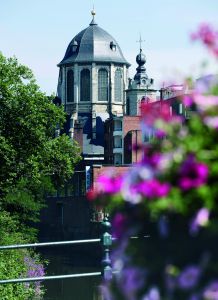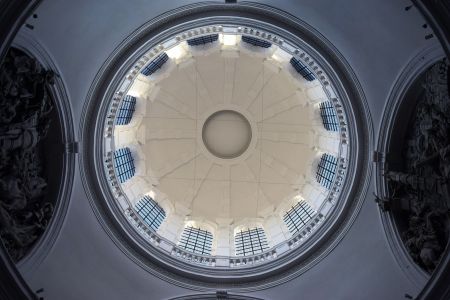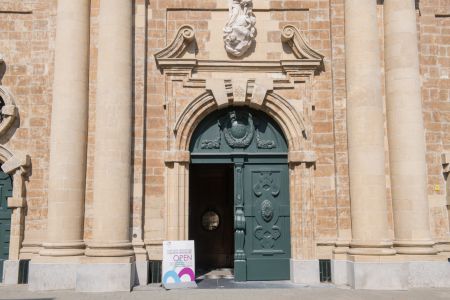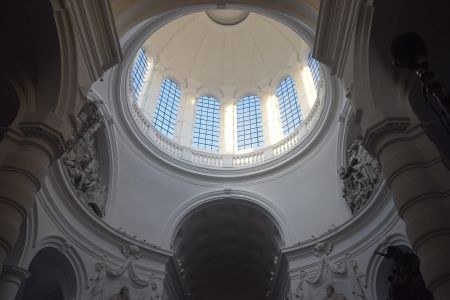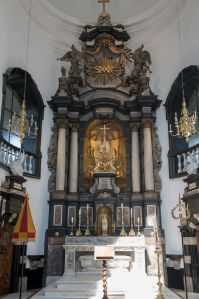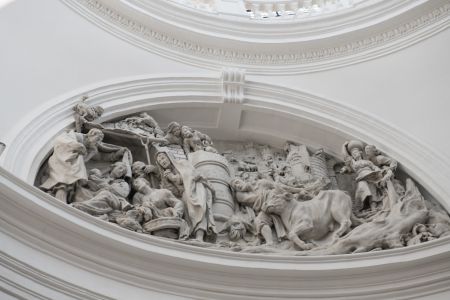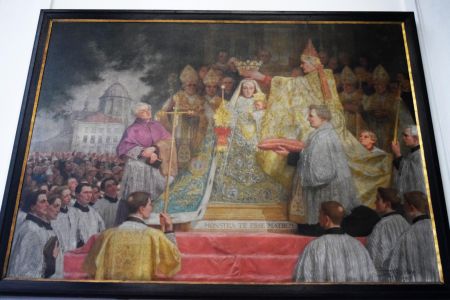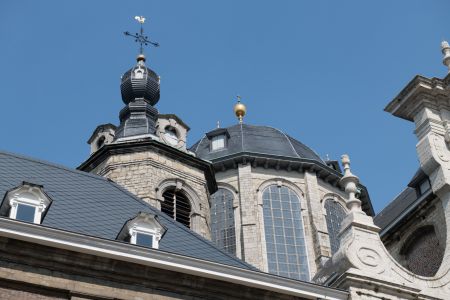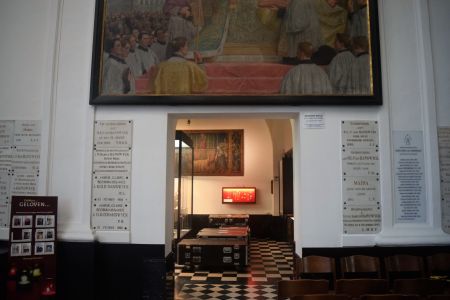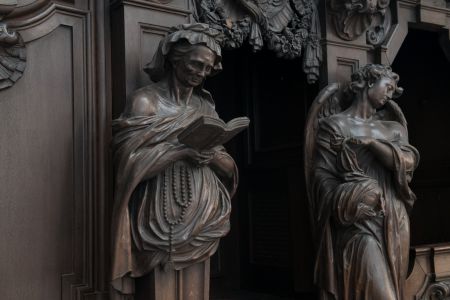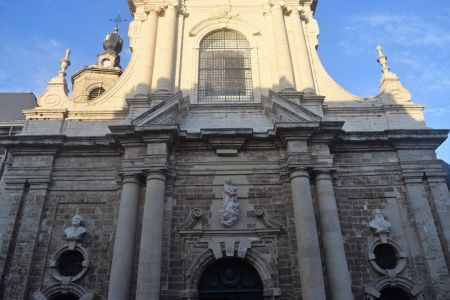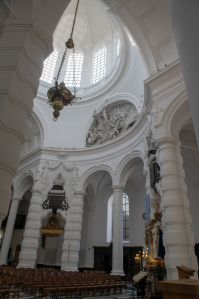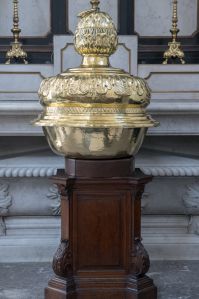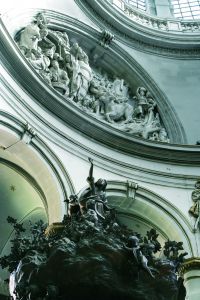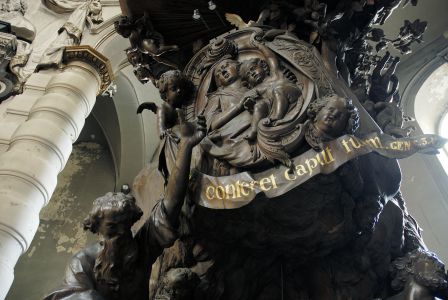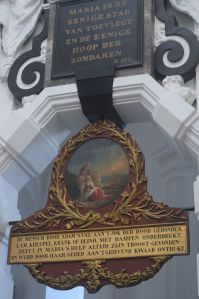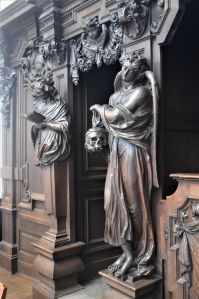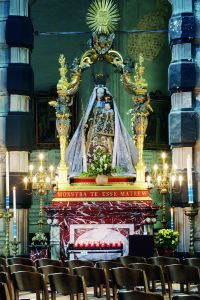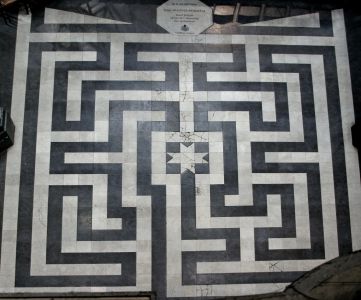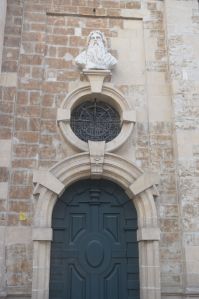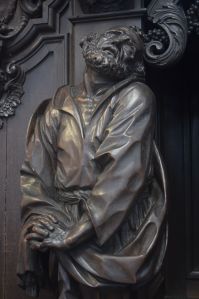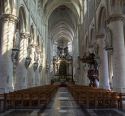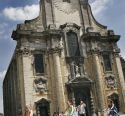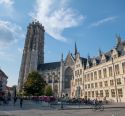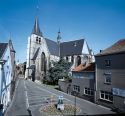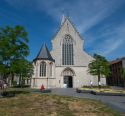Basilica | 1663 | Baroque | Catholic Church

Map
Opening hours
01 April - 31 October
Mon 9.00 - 17.00
Tue 9.00 - 17.00
Wed 9.00 - 17.00
Thu 9.00 - 17.00
Fri 9.00 - 17.00
Sat 9.00 - 17.00
Sun 9.00 - 17.00
01 November - 31 March
Mon 9.00 - 16.00
Tue 9.00 - 16.00
Wed 9.00 - 16.00
Thu 9.00 - 16.00
Fri 9.00 - 16.00
Sat 9.00 - 16.00
Sun 9.00 - 16.00
Guided tour
Religious offices
Description
The baroque church, as a place of pilgrimage, was designed by Lucas Faydherbe and built between 1663 and 1681. The church has a unique ground plan, combining 3 aisles with a central building. It is one of the first domed churches in the Low Countries.
Since 988 A.D. the miraculous statue of the Holy Mary is central to the church’ interior. According to legend, a heavily loaded ship stranded on the shores of the river Dijle, and became afloat again only after a statue of the Holy Mary was brought to the river shore in the district of Hanswijk. The people’s conclusion was that the Holy Mary wished to be worshipped in that spot.
When Malines was ravished by the plague in 1272 the people carried the statue in procession to the cathedral of St. Rombouts and the plague ended a few days later. Since then the Hanswijk procession is held yearly in grateful remembrance.
Started in 1738, at the 750th anniversary of the start of the devotion, a Hanswijk cavalcade is held every 25 years, a unique historical pageant last organised in 2013.
The church of Hanswijk was granted the status of basilica on October 6th 1987 by pope John Paul II in recognition of its function as important place of pilgrimage (988-1988).
The church of Our Lady of Hanswijk is one of 7 historic churches in Malines, promoted by Torens aan de Dijle, in cooperation with the city of Malines.
KIKIRPA : Photo-library online
Photos
Media
Remarkable elements
Images in relief underneath the dome
Two big bas-relieves adorn the space above the columns of the rotunda. They display Christ carrying the cross and the adoration of the shepherds. Until the bombings of World War II everyone assumed they were carved out of sandstone, but in fact this type of stone would have been too heavy and the ingenious architect Faydherbe placed bas-relieves to solve this problem. It wasn’t until the damaged relieves were restored that this deception was discovered.
Confessionals at the hands of Jan-Frans Boeckstuyns (1650-1734)
Some confessionals are attributed to Jan Frans Boeckstuyns. The northeastern confessional is adorned with four thematic opposites: Death, The last judgment, Paradise and Hell. The repentant Petrus, the Angel with the initialism INRI, the angel with the veil of Veronica and the Holy Hieronymus are represented on the northwestern confessional. The southeastern confessional is less elaborate, it’s creator remains unknown. The pediment is adorned with the image of our unsullied Holy Virgin who is depicted as Maria our savior. She supports the Child that crushes the snake of evil.
Pulpit of Theodor Verhaegen (1701-1759)
This pulpit is considered one of the crown jewels of this church. It was ordered on the 4th of May 1743 for the price of 4000 Dutch guilders. Alexander-Jozef Rubens, grandson of the famous Peter Paul Rubens donated 2994 Dutch guilders for this purpose.
The pulpit was sculpted in 1746 by the Mechlin woodcarver Theodoor Verhaegen. The pulpit shows the mariology. Two life-sized statues at the bottom represent Adam and Eve after the Fall of men. Jahweh, depicted as an old man with a beard, casts Adam and Eve from paradise. With his one hand he shows the serpent crawling on the ground, with the other one he points to the medallion on the barrel which shows a depiction of the Holy Virgin Mary with her child. Forgiveness and salvation are promised. Above the soundboard the assumption of Mary guided by angels is shown. A tall tree with wide branches and a long drapery carried by angels overshadows the whole.
Statue of the Holy Virgin Mary
In the 10th century a loaded ship stranded at the bank of the river The Dyle in the hamlet of Hanswijk. It proved impossible to move until the statue of our Holy Virgin Mary was brought to land. When the statue of Mary was unloaded, as the last item on the ship, the vessel miraculously started to move again. The people living in the neighborhood and the sailormen saw this event as a sign. They believed that the statue wanted to live in the region of Hanswijk. It was taken to a nearby chapel dedicated to the Holy Lambertus and Catharina. The chapel quickly became a popular place of pilgrimage. It was mentioned for the first time in 1263 by Thomas van Cantimpré, a Brabant Black Friar of Kamerijk.
The original statue disappeared in the 16th century. The current statue, 1,45 meters high, is made out of walnut. The curled braids of Mary curl down her back and partly in front of her shoulders. Mary holds a scepter in her right hand while she carries her child, Jesus, at her left side. The child leans against the chest of his mother whilst holding an apple in his right hand.
The statue is in good condition and still shows marks of the old polychromes. The back of the statue bares a mark from an unknown artist: two intersecting triangles. This statue of the Holy Virgin Mary is carried along in the yearly Hanswijk procession.
Dome
The necessary capital sum to build a new church and monastery was collected in 1663. The appointed architect, Lucas Faydherbe, came up with an exceptional ground plan. The first stone was layed on the 10th of May 1663 by Andreas Cruesen, the archbishop of Machlin.
The building terrain, a swampy and sloping bank of the river The Dyle posed a first challenge. The unusual ground plan of the church posed a second challenge: an uncommon combination of a traditional three naval basilica and a domed church. To ensure an uninterrupted view at the main altar Faydherbe was looking to eliminate the supporting pillars of the dome at the intersection with the center.The church was almost completed in 1676. The central dome was the only architectural element that wasn’t fully completed. Although the building process proceeded fairly smoothly the workmen were still confronted with some unexpected serious stability problems. The southern pillar at the side of the choir was heeling over badly; it deviated a whopping 25 centimeters and thereby compromised a safe and stabile building of the dome. To strengthen the arcade of pillars, eight of the ten circular pillars were connected per two to form block porticos. The original design equipped the dome design with a two leveled tambour. The stability problems forced the architect to limit himself to one high clerestory with twelve semi-circular windows.
Labyrinth of Hanswijk
In the floor pattern of the Hanswijk Basilica you can see a labyrinth pattern. Walking in a labyrinth has a spiritual meaning, hence the many findings of such patterns in churches. The path symbolizes the Christians who will not lose their way despite terrible ordeals, uncertainties and disappointments. God leads them on the righteous path. The labyrinth is also a way to contemplate, by walking the path you take on a spiritual travel that leads to one’s inner self. Whilst walking the travelers can reflect in order to reach their heart in a chastened state. To fully indulge in the religious experience it is of importance to take this path on your knees. Labyrinths were especially popular during the gothic period. The labyrinths of the cathedrals of Amiens and Chartres are excellent examples. The labyrinth in the Van Hanswijk basilica can contend with latter. After the Middle Ages the tradition of the Labyrinth sank into oblivion. This labyrinth that probably dates back to the 19th century is therefore a real gem.
Donations to Our Lady of Hanswijk
The parish of Hanswijk has received a lot of donations in honor of Our Lady of Hanswijk. The basilica of Hanswijk also is in possession of crown jewels that were paid for with money collected from the Mechlin population. The basilica is also in possession of a large collection of chalices and other church vessels, a remarkable collection of jewels including necklaces, brooches, tie-clips, rings, hairpins, watches and expensive rosaries that were donated out of gratitude for granted favors. Sporadically they are displayed in the basilica.
The category of ex-voto’s consists of votive paintings, commemorative plaques, stools and small antropomorf objects. The practice of this genre of portraits originates in 15th century Italy. Votive painting spreads to other European countries in the 16th century under which France. These specific kinds of paintings are mainly ordered by the upper class. It was only until after the explosive expansion of places of pilgrimage that the use of such paintings gained popularity in the Southern Netherlands and the German speaking countries.
It is a remarkable fact that the collection of Hanswijk consists solely of children’s portraits even though the distinction with adults can’t always be made. This practically exclusive presence of children’s portraits isn’t that strange since the Holy Mary is known for her caring abilities as the mother of Jesus and had a weak spot for the youngest among us according to tradition.




